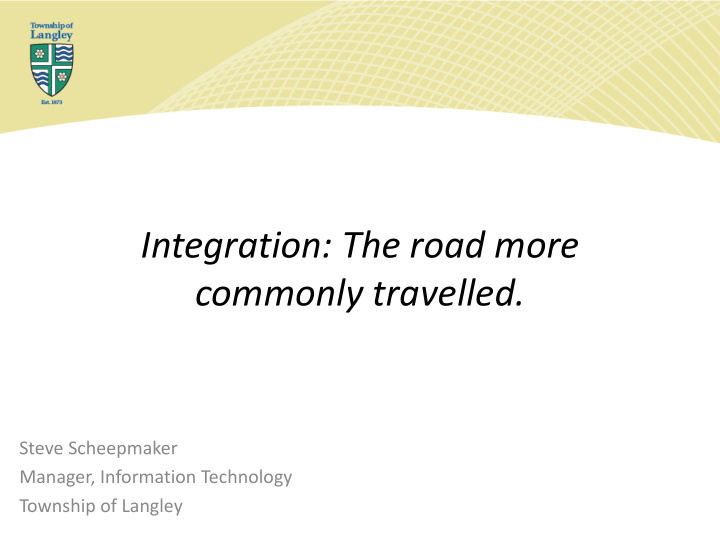



Integration: The road more commonly travelled. Steve Scheepmaker Manager, Information Technology Township of Langley
A lighthearted presentation covering the following topics: • What is Integration? • What should you consider? • What are some of the options? • Examples
“What is Integration?”
“Integration is a process of combining or accumulating.” (WikiPedia)
“To form, coordinate, or blend into a functioning or unified whole.” (Webster’s)
Integration is becoming more and more mainstream…. … actually, there is (and should be) an expectation to have “touch points” available for integration purposes.
In GIS, integration generally involves meshing together spatial and/or attribute data into a homogeneous dataset.
As GIS becomes a core component of the enterprise landscape, the need to integrate GIS with other “traditional” enterprise applications is becoming much more common.
“So I want to integrate, now what?”
“What are you trying to do?” • Business Process Integration • Data Integration • Something else?
“What do you need?” • One way • Bi ‐ directional • Aggregation
“What other factors do I need to consider?” • Latency • Performance • Data structure/quantity • Transaction load
“One Source”
The “One Source” philosophy states: “We must provide efficient access to information while attempting to consolidate and eliminate data redundancy and duplication whenever possible.”
At the Township of Langley, the “One Source” philosophy is helping drive our integration needs and requirements.
“What are my options?” • “Duct tape and rubber bands” • RDBMS • Application integration • Enterprise integration
“Duct tape and rubber bands” Do whatever it takes...
As long as you have: • A full pack of bubble gum • Swiss army knife • A license of Access and/or Excel You can make anything happen!
RDBMS Leverage capabilities of the RDBMS to perform integration at the data level.
RDBMS ‐ Example Requirement: 1. Leverage property information stored within the Land Management System inside the GIS system. 2. Minimize duplication if possible
RDBMS ‐ Example Solution: Perform a “join” at the database level to aggregate information stored in the GIS and the land management system.
RDBMS ‐ Example Solution:
RDBMS ‐ Example Solution:
Application Integration Leverage capabilities of a particular application or development environment to integrate at the application level.
Application Integration ‐ Challenges Application “A” Application “B” One challenge is the inherent system boundaries… …as long as the vendor has provided the “touch point”
Application Integration ‐ Options Many options provided by the operating system for Inter ‐ process Communication (IPC): COM • Windows messaging • DDE • Etc. • … All are accessible using a number of development environments
Application Integration ‐ Example Requirement: 1. Utilize GIS functionality within the Land Management System 2. Leverage existing web ‐ mapping tool to minimize the need for end ‐ user training
Application Integration ‐ Example Solution: Leverage application level integration touch ‐ points to integrate existing web ‐ mapping tool with the Land Management System.
Application Integration ‐ Example Solution:
Application Integration ‐ Example Solution:
Application Integration ‐ Example What’s happening under the hood? • Windows messaging • HTTP POST • Database operations
Enterprise Integration Leverage inherent capabilities of a enterprise architecture or middleware to perform required integration.
Enterprise Integration ‐ Explanation Lengthy and complicated topic… … if you thought we had too many acronyms and confusing terminology before…
Enterprise Integration ‐ Explanation ESB Federated SOAP Yikes!! Synchronous Queue Middleware REST Messaging Mediated SOA Asynchronous
Enterprise Integration ‐ Explanation Holy SOAP Batman! I can’t access my WSDL, the ESB does not want to respond and it appears that my Middleware might have failed!
Enterprise Integration ‐ Explanation You are freaking me out Robin! WSDL, ESB and your Middleware – do I need to drive you to the doctor?
Enterprise Integration ‐ Explanation In a nutshell: • There is a real paradigm shift occurring in how we view the enterprise; integrating systems is a requirement. • GIS will play even a more important role on the enterprise landscape in the years to come.
Enterprise Integration ‐ Explanation Just one of the many new advancements helping enable enterprise integration… Service ‐ Orientated Architecture (SOA): SOA establishes an architecture from which applications expose methods (building blocks) for other enterprise applications.
Enterprise Integration ‐ Options Other integration options available: • BizTalk • SQL Server Integration Services (SSIS) • Vendor specific (Web services, etc.) • Too many to list!
Enterprise Integration ‐ Example Requirement: Implement integration between the following systems: ‐ Municipal business license database ‐ Regional land inventory database ‐ Motor vehicles database ‐ Police mainframe
Horatio says: “Integration is cool!”
Enterprise Integration ‐ Example “By correlating all owners of dog grooming businesses that recently obtained a class 4 drivers license we determined that the killer has brown hair and lives in a 2 bedroom condo within two kilometers of a freeway onramp – now only if we had a GIS…”
Enterprise Integration ‐ Example Requirement: Need to access images in catalog system directly inside other corporate systems
Enterprise Integration ‐ Example Solution: Encapsulate business logic for image search inside of a web service and leverage that functionality in other enterprise applications.
Enterprise Integration ‐ Example Image Catalog Solution: …/_WsLglPlan.asmx Web Mapping [GetLegalPlansByNumber(string)] SharePoint
Enterprise Integration ‐ Example …/_WsLglPlan.asmx [GetLegalPlansByNumber(string)]
In Summary: • Technology is continuing to evolve. • Integration is becoming a requirement. • GIS vendors are helping with this. • Plan your integrations carefully. • Try to think modular/ think big picture. • We are only just beginning…
Thanks!
Recommend
More recommend